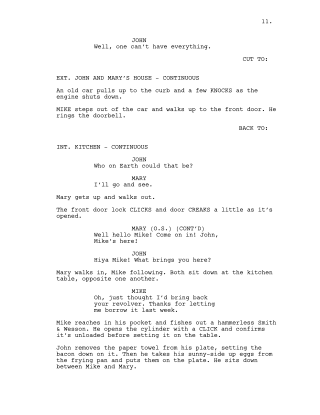Related Research Articles

A screenwriter is a writer who practices the craft of screenwriting, writing screenplays on which mass media, such as films, television programs, and video games, are based.

In a literary work, film, or other narrative, the plot is the sequence of events in which each event affects the next one through the principle of cause-and-effect. The causal events of a plot can be thought of as a series of events linked by the connector "and so". Plots can vary from the simple—such as in a traditional ballad—to forming complex interwoven structures, with each part sometimes referred to as a subplot or imbroglio.
A screenplay, or script, is a written work produced for a film, television show, or video game by screenwriters. A screenplay written for television is also known as a teleplay. Screenplays can be original works or adaptations from existing pieces of writing. A screenplay is a form of narration in which the movements, actions, expressions and dialogue of the characters are described in a certain format. Visual or cinematographic cues may be given, as well as scene descriptions and scene changes.

Sydney Alvin Field was an American author and speaker who wrote several books on screenwriting, the first being Screenplay: The Foundations of Screenwriting. He led workshops and seminars about producing salable screenplays. Hollywood film producers use Field's ideas on structure to measure the potential of screenplays.
A film treatment is a piece of prose, typically the step between scene cards and the first draft of a screenplay for a motion picture, television program, or radio play. It is generally longer and more detailed than an outline, and it may include details of directorial style that an outline omits. Treatments read like a short story, but are told in the present tense and describe events as they happen. A treatment may also be created in the process of adapting a novel, play, or other pre-existing work into a screenplay.

Screenwriting or scriptwriting is the art and craft of writing scripts for mass media such as feature films, television productions or video games. It is often a freelance profession.

Philip Ives Dunne was an American screenwriter, film director and producer, who worked prolifically from 1932 until 1965. He spent the majority of his career at 20th Century Fox. He crafted well regarded romantic and historical dramas, usually adapted from another medium. Dunne was a leading Screen Writers Guild organizer and was politically active during the "Hollywood Blacklist" episode of the 1940s–1950s. He is best known for the films How Green Was My Valley (1941), The Ghost and Mrs. Muir (1947), The Robe (1953) and The Agony and the Ecstasy (1965).
A log line or logline is a brief summary of a television program, film, short film or book, that states the central conflict of the story, often providing both a synopsis of the story's plot, and an emotional "hook" to stimulate interest. A one-sentence program summary in TV Guide is a log line. "A log line is a single sentence describing your entire story," however, "it is not a straight summary of the project. It goes to the heart of what a project is about in one or two sentences, defining the theme of the project...and suggest[ing] a bigger meaning." "A logline is a one-sentence summary of the story's main conflict. It is not a statement of theme but rather a premise."
Fiction writing is the composition of non-factual prose texts. Fictional writing often is produced as a story meant to entertain or convey an author's point of view. The result of this may be a short story, novel, novella, screenplay, or drama, which are all types of fictional writing styles. Different types of authors practice fictional writing, including novelists, playwrights, short story writers, radio dramatists and screenwriters.
A narrative hook is a literary technique in the opening of a story that "hooks" the reader's attention so that they will keep on reading. The "opening" may consist of several paragraphs for a short story, or several pages for a novel, but ideally it is the opening sentence in the book.
A spec script, also known as a speculative screenplay, is a non-commissioned and unsolicited screenplay. It is usually written by a screenwriter who hopes to have the script optioned and eventually purchased by a producer, production company, or studio.

Karen McCullah is an American screenwriter and novelist most known for co-writing comedies such as 10 Things I Hate About You, Legally Blonde, Ella Enchanted, The House Bunny, The Ugly Truth and She's the Man with her screenwriting partner Kirsten Smith. After graduating from James Madison University with a degree in marketing, McCullah worked various jobs before beginning to write. She is a faculty member at Syracuse University's Los Angeles Semester.
Screenwriting software are word processors specialized to the task of writing screenplays.
A scriptment is a written work by a movie or television screenwriter that combines elements of a script and treatment, especially the dialogue elements, which are formatted the same as in a screenplay. It is a more elaborate document than a standard draft treatment. Some films have been shot using only a scriptment.
Movie Outline is a word processing program developed by Nuvotech Limited. It is used to step outline a cinematic story and format a screenplay. It was created by Dan Bronzite, an English screenwriter. It was released in 2004 as an outliner with more features added in later releases.

Sophocles was a Windows-based screenwriting software application used for writing feature film and television screenplays. The program first became available on the Internet in 1999. Its distinguishing features included a two window screen setup, showing the script and screenplay outline simultaneously.
The three-act structure is a model used in narrative fiction that divides a story into three parts (acts), often called the Setup, the Confrontation, and the Resolution. It was popularized by Syd Field in his 1979 book Screenplay: The Foundations of Screenwriting. Based on his recommendation that a play have a "beginning, middle, and end," the structure has been falsely attributed to Aristotle, who in fact argued for a two-act structure consisting of a "complication" and "dénouement" split by a peripeteia.
Blake Snyder was an American screenwriter, consultant, author and educator based in Los Angeles. His screenplays include the comedies Stop! Or My Mom Will Shoot (1992) and Blank Check (1994).

A stage reading, also known as a staged reading, is a form of theatre without sets or full costumes. The actors, who read from scripts, may be seated, stand in fixed positions, or incorporate minimal stage movement.
Video game writing is the art and craft of writing scripts and narratives for video games. Similar to screenwriting, it is typically a freelance profession. It includes many differences from writing for film, due to the non-linear and interactive nature of most video games, and the necessity to work closely with video game designers and voice actors. There are many differing types of text in video games in comparison to stage shows or movies, including written text, foreign or made-up languages, and often situation-based information. Especially when developing Triple A games, more than one writer will be required to create the game, split into different roles.
References
- ↑ Hauge, M. (2011). Writing Screenplays That Sell, New Twentieth Anniversary Edition: The Complete Guide to Turning Story Concepts into Movie and Television Deals. Harper Collins.
- ↑ Field, S. (2005). Screenplay: The Foundations of Screenwriting. Delta.
- ↑ Trottier, D. (2019). The Screenwriter's Bible, 7th Edition, A Complete Guide to Writing, Formatting, and Selling Your Script. Silman-James Press.
- ↑ Lerch, J. (1999). 500 Ways to Beat the Hollywood Script Reader: Writing the Screenplay the Reader Will Recommend. Fireside.
- ↑ The Black List. (n.d.). About. https://blcklst.com/about/
- ↑ Hicks, N. (2011). Screenwriting 101: How to Get Your Movie Idea Onto the Silver Screen. BT Elite Publishers LLC.
- ↑ Blue Stocking Press. (n.d.). Screenplay Competitions. https://www.bluestockingpress.com/screenplay-competitions.htm
- ↑ Kirkland, C. (2011). I Liked It, Didn't Love It: Screenplay Development from the Inside Out. Lone Eagle.
- ↑ Prescene. (n.d.). AI Script Coverage. https://www.prescene.ai/